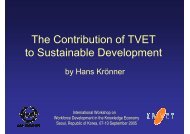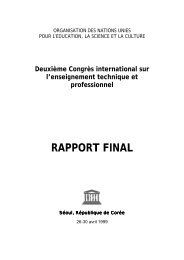Learning for Life, Work and the Future Initial ... - Unesco-Unevoc
Learning for Life, Work and the Future Initial ... - Unesco-Unevoc
Learning for Life, Work and the Future Initial ... - Unesco-Unevoc
You also want an ePaper? Increase the reach of your titles
YUMPU automatically turns print PDFs into web optimized ePapers that Google loves.
<strong>Learning</strong> <strong>for</strong> <strong>Life</strong>, <strong>Work</strong> <strong>and</strong> <strong>the</strong> <strong>Future</strong> Participants’ Papers Page 61<br />
15 MAJELA, Thelma K. (Botswana): Recalibrating <strong>and</strong> Refocusing TVET:<br />
Setting up a Therapeutic Environment<br />
1. Introduction<br />
Like o<strong>the</strong>r countries in sou<strong>the</strong>rn Africa, Botswana has<br />
experienced exponential dem<strong>and</strong> <strong>for</strong> tertiary education,<br />
particularly in student numbers <strong>and</strong> courses offered. In<br />
<strong>the</strong> past, tertiary education was regarded as <strong>the</strong> last<br />
resort after people had exhausted all <strong>the</strong> possible<br />
desired career options. The new trend clearly requires<br />
a new approach to career exploration. A typical<br />
example is <strong>the</strong> recently conducted entrance interviews<br />
<strong>for</strong> places in <strong>the</strong> new Gaborone VTC, where approximately<br />
18,000 people applied <strong>for</strong> 1,500 places. The<br />
scenario raises concerns about <strong>the</strong> characteristics of <strong>the</strong><br />
learners, <strong>the</strong>ir academic background <strong>and</strong> <strong>the</strong> life<br />
experiences <strong>the</strong>y bring into <strong>the</strong> institution, to mention a<br />
few. Moreover, <strong>the</strong> level of preparedness of those<br />
dealing with <strong>the</strong> learners is an equally important area<br />
of concern <strong>for</strong> education re<strong>for</strong>m.<br />
2. Philosophical Assumptions<br />
The philosophical assumptions guiding <strong>the</strong> conceptualization<br />
of <strong>the</strong> paper are based on <strong>the</strong> underst<strong>and</strong>ing<br />
that people are unique in <strong>the</strong>ir personal characteristics<br />
<strong>and</strong> yet <strong>the</strong>y possess a complex reality that is influenced<br />
by various components. We all exist within a<br />
phenomenological worldview that is heavily influenced<br />
by our personal, social, psychological, spiritual, cultural,<br />
political, economic <strong>and</strong> educational contextual<br />
realities. These realities are not mutually exclusive <strong>and</strong><br />
<strong>the</strong>re<strong>for</strong>e remain closely intertwined. The implication<br />
is that if a single component is not balanced, one is<br />
likely to feel psychologically fractured, unbalanced <strong>and</strong><br />
disempowered, <strong>and</strong> will experience disequilibria ei<strong>the</strong>r<br />
at a personal <strong>and</strong>/or interpersonal level. A wellfunctioning<br />
person will have all in synergy <strong>and</strong><br />
synchronized to maximize individual potential <strong>and</strong><br />
capabilities. The role of <strong>the</strong> institution is to recognize<br />
<strong>and</strong> appreciate <strong>the</strong> imperative existence of all <strong>the</strong>se<br />
facets of student life <strong>and</strong> to strive towards addressing<br />
<strong>the</strong>m in totality.<br />
3. Character of <strong>the</strong> Student Population<br />
The development <strong>and</strong> implementation of <strong>the</strong> policy on<br />
equal opportunities in <strong>the</strong> MoE is a giant step towards<br />
equitable access to <strong>and</strong> sharing of resources. Technical<br />
institutions will have a new student population with<br />
different family backgrounds, gender composition,<br />
special needs, ethnic origins <strong>and</strong> o<strong>the</strong>rs. However,<br />
such diversity presents a paradox because it both<br />
streng<strong>the</strong>ns <strong>the</strong> environment <strong>and</strong> yet may be a challenge<br />
<strong>for</strong> those who do not know how to deal with it.<br />
Consideration must be given to:<br />
The culture of learning:<br />
It is a reality that many of <strong>the</strong> students entering<br />
vocational institutions have been trapped in <strong>the</strong><br />
backlog that could not be addressed by <strong>the</strong> limited<br />
training spaces. Effective study skills <strong>and</strong> techniques<br />
<strong>and</strong> general conceptualization may be a challenge.<br />
Career guidance:<br />
Some students chose vocational <strong>and</strong> technical<br />
education as a last resort because <strong>the</strong>y were probably<br />
out-competed in <strong>the</strong>ir initial choices. This is very<br />
dangerous <strong>and</strong> may lead to high drop-out rates <strong>and</strong><br />
dissatisfaction in <strong>the</strong> workplace.<br />
Morale <strong>and</strong> motivation level:<br />
Many of <strong>the</strong> learners have been exposed to repeated<br />
failure <strong>and</strong> o<strong>the</strong>r demoralizing situations. It is critical<br />
to recognize <strong>the</strong> internalized feeling of inadequacy that<br />
could be perpetuated through <strong>the</strong> self-fulfilling prophecy,<br />
leading to complacency <strong>and</strong> counter-productivity.<br />
Self-esteem <strong>and</strong> self-confidence:<br />
The continued feeling of rejection by <strong>the</strong> self, o<strong>the</strong>rs,<br />
<strong>and</strong> institutions of authority can lead to low selfesteem.<br />
The value that one gives to <strong>the</strong> self is critical<br />
in terms of internal growth, life aspirations <strong>and</strong> vision.<br />
Exposure to socio-economic <strong>and</strong> psychosocial<br />
dynamics:<br />
Many of <strong>the</strong> learners have been exposed to <strong>the</strong> rigours<br />
<strong>and</strong> challenges of life that include poverty, unemployment,<br />
retrenchment, substance abuse, suicide, HIV/<br />
AIDS <strong>and</strong> teenage pregnancy, to mention a few. This<br />
means that institutions have students who are ei<strong>the</strong>r <strong>the</strong><br />
primary or secondary victims of <strong>the</strong> stated ills <strong>and</strong> need<br />
help to cope <strong>and</strong> function effectively.<br />
Multiple roles <strong>and</strong> functions:<br />
Many of <strong>the</strong> students per<strong>for</strong>m multiple roles <strong>and</strong><br />
functions in life. These include being spouses/companions,<br />
parents, siblings, caretakers or employees, <strong>and</strong><br />
some play <strong>the</strong>m all simultaneously. It is important that<br />
<strong>the</strong> learning environment recognizes <strong>the</strong>se challenging<br />
roles <strong>and</strong> assists <strong>the</strong> learner to juggle <strong>the</strong>m all<br />
effectively.<br />
Varied coping resources:<br />
Students bring coping resources that are fully entrenched<br />
in <strong>the</strong>ir behavioural repertoires <strong>and</strong> have been<br />
internalized in <strong>the</strong>ir world view. Some of <strong>the</strong> coping<br />
resources may be maladaptive <strong>and</strong> need reshaping.





